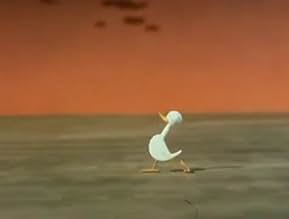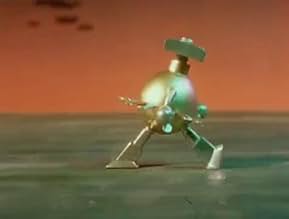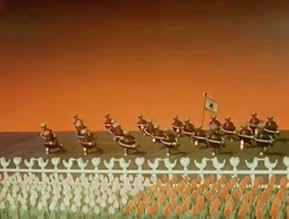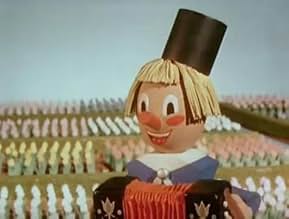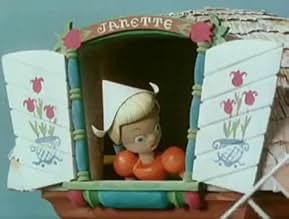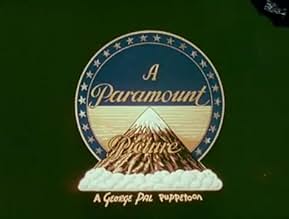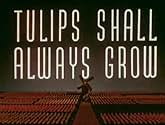अपनी भाषा में प्लॉट जोड़ेंA carefree boy and a young girl find their idyllic countryside invaded by an army of mindlessly destructive robots.A carefree boy and a young girl find their idyllic countryside invaded by an army of mindlessly destructive robots.A carefree boy and a young girl find their idyllic countryside invaded by an army of mindlessly destructive robots.
- निर्देशक
- लेखक
- 1 ऑस्कर के लिए नामांकित
- 1 जीत और कुल 1 नामांकन
फ़ीचर्ड समीक्षाएं
The story begins in Holland in happy times, until a bunch of fascist war machines come in and destroy everything. A boy and girl are in the middle of it and experience incredible sadness. The arrival of the awful machines is really the high point (though violent) as the devastate the country.
'Tulips Shall Grow (1942)' is a wartime 'Puppetoon' in which a young pair of lovers come under threat when an invading force of unfeeling machines starts to destroy their idyllic countryside home. The short starts out as a whimsical love story, its charming aesthetic enhancing its tried-and-tested romance. After a couple of minutes, though, it takes a hard left turn into all-out war. This sequence doesn't pull any punches; though no humans are shown to be harmed, the machines do absolutely devastate the environment and bomb every windmill in sight. The short is, in essence, an anti-war piece made in the midst of a very real war. It's not hard to see that the machines are an allegory for the Nazis and that the setting is meant to represent one of the European countries they invaded. The anti-war sentiment only really exists in the sense that we're shown how it decimates an innocent environment; it isn't any deeper than that. However, perhaps that's to be expected at a time when the war had to be won, rather than prevented. The picture is kind of unrealistic and, as such, it sort of trivialises the power of the opposing force. It's easy to see why it aims for overt optimism, though, and a message that ultimately says (as its title suggests) that peace and prosperity can in fact emerge from a war-torn world would've been incredibly pertinent at the time it was released. It's designed to tell the public that everything will be okay in the end. It's a little naïve in retrospect (after all, the filmmakers couldn't be sure the war would end in a favourable way), but it basically presents the right message at the right time if you view it in the context of its release. It's a solid effort. 6/10.
For no other reason than curiosity, I have watched all the short animated films nominated for the Oscar in the 15th Academy Awards. Most of them (including the winning film) are propaganda pieces and this includes Tulips Shall Grow which is a very specific one. The film is targeted towards the resistance in Holland during the occupation and, although it is not light in its touch, it is a more engaging message than some of the other propaganda films which are heavy on the criticism of the enemy and the glorification of the home nation. Of course I understand why such films are this way, but it is nice that this is a little different.
The difference is that the message is one of resilience, survival and resistance – not one of dominance or mockery and for the time and situation this is more appropriate and also more palatable as a message. The film is simple; done in stop-motion we see Holland attached by machines which destroy the images that we are used to seeing (windmills, clogs and of course tulips). The victory does come of course but I additionally liked that it was a victory that was brought about more or less by the very things that makes Holland be Holland – the elements, the nature, the conditions. The symbolism is very obvious but it is effective and it is a nice message from the film and one that I personally prefer to some of the more flag-waving shorts in the same category, even if technically several of the other animated shorts are better than this one.
So it is still another propaganda piece but it is a nice change of pace that it has a message of resistance rather than dominance and it was refreshingly free of flag waving and the like.
The difference is that the message is one of resilience, survival and resistance – not one of dominance or mockery and for the time and situation this is more appropriate and also more palatable as a message. The film is simple; done in stop-motion we see Holland attached by machines which destroy the images that we are used to seeing (windmills, clogs and of course tulips). The victory does come of course but I additionally liked that it was a victory that was brought about more or less by the very things that makes Holland be Holland – the elements, the nature, the conditions. The symbolism is very obvious but it is effective and it is a nice message from the film and one that I personally prefer to some of the more flag-waving shorts in the same category, even if technically several of the other animated shorts are better than this one.
So it is still another propaganda piece but it is a nice change of pace that it has a message of resistance rather than dominance and it was refreshingly free of flag waving and the like.
This cartoon is a masterpiece. While a lot of people think George Pal was a closed-minded racist because of his "Jasper" shorts, this short proves that he clearly wasn't. Like a lot of cartoons from this time period, it was anti-Nazi propaganda, but unlike a lot of cartoons, It actually focuses on the Holocaust, rather than just winning the war, like most WWII shorts. George Pal, living in Europe throughout the 1930s, experienced the Holocaust first-hand. He wasn't Jewish, but it still upset him to see the Nazis burn down buildings and kill Jews. So, when he came to America to make more films and escape the draft, he made this. Overall, it is a great cartoon. It can still be shown on T.V. today, because the "Nazis" are really robots called the screwballs. If your a teacher, you might even show it to your history class!
10llltdesq
This short, nominated for an Academy Award, was made by George Pal and concerns an invasion by mechanized war machines in a place obviously modeled on Holland, which was under occupation by the Nazis at the time. It is a tribute to the ability of humanity to persevere against the worst imaginable events and no only survive, but thrive. It is incorporated into The Puppetoon Movie and is a wonderful piece of work. The ending is glorious! Most highly recommended.
क्या आपको पता है
- ट्रिवियाIn 1997, the film was selected for preservation in the United States National Film Registry by the Library of Congress as being "culturally, historically, or aesthetically significant".
- गूफ़Wrong year in the wrong year.
- कनेक्शनFeatured in The Fantasy Film Worlds of George Pal (1986)
टॉप पसंद
रेटिंग देने के लिए साइन-इन करें और वैयक्तिकृत सुझावों के लिए वॉचलिस्ट करें
विवरण
- रिलीज़ की तारीख़
- कंट्री ऑफ़ ओरिजिन
- भाषा
- इस रूप में भी जाना जाता है
- Madcap Models No. U1-5: Tulips Shall Grow
- उत्पादन कंपनियां
- IMDbPro पर और कंपनी क्रेडिट देखें
- चलने की अवधि7 मिनट
- पक्ष अनुपात
- 1.37 : 1
इस पेज में योगदान दें
किसी बदलाव का सुझाव दें या अनुपलब्ध कॉन्टेंट जोड़ें


